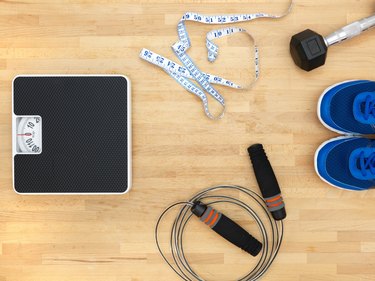
An aggressive weight loss plan incorporates both a strenuous exercise program and a low-calorie eating plan. Basically, if you burn more calories than you consume, you'll lose weight. By combining 300 minutes per week of moderate- to high-intensity exercise with a healthy, low-calorie, low-fat diet, you can maximize your weight loss without endangering your health.
Cutting Calories
Video of the Day
Your body stores about a pound of fat for every 3,500 surplus calories you eat. Conversely, cutting 3,500 calories will result in the loss of that pound. Subtracting 500 calories a day gives you an average weight loss of about a pound a week, even if you do no additional exercise. Doubling that figure and shaving 1,000 calories a day from your calorie intake could double that figure to two pounds a week -- a safe, but more rapid weight loss. Speak to your doctor and keep your calories above 1,200 calories per day, the minimal daily calorie consumption that the American College of Sports Medicine recommends.
Video of the Day
Adding Nutrition
Because foods have such variable calorie contents, what you eat on your calorie-restricted plan probably has a great deal to do with your meal satisfaction. When you add low-calorie, high-volume foods to your meals, your stomach feels full and helps you resist the urge to snack. You'll also get additional fiber, vitamins and minerals with the addition of bulky, but low-calorie, foods such as salads, steamed vegetables and fruits. Your body requires all three macronutrients -- fats, carbohydrates and proteins -- for optimal health, but when you eat more of your carbs in the form of leafy vegetables and high-fiber whole grains, you'll get more nutritional value for your calorie expenditure. Choose whole grains, lean meats, fruits and vegetables more often than calorie-dense foods, and your calorie budget will stretch further.
Increasing Exercise
The other side of the weight loss equation from calorie intake is calorie expenditure. Increasing your exercise helps you burn more calories, not only for the duration of your workout, but also for an hour or more after you rest. Building muscle can also help you lose fat because muscle is more metabolically costly for your body to maintain. Extra muscle burns more calories, even when you're at rest. Exercise quickens your metabolic rate and contributes to a more aggressive weight-loss program.
Non-Exercise Activity Thermogenesis
The Centers for Disease Control and Prevention recommends getting a minimum of one-half hour of exercise five days a week, but you can get that exercise in smaller blocks if an uninterrupted half-hour interval rarely comes your way. Non-exercise activity thermogenesis, or NEAT, refers to all the work your body counts as exercise, such as shopping, walking the dog or climbing a flight of stairs. The more you increase your NEAT, the more overall exercise you'll get, and the larger your calorie deficit becomes. Get in the habit of walking or biking instead of driving to nearby destinations to burn more calories via NEAT.
Considerations
Always speak to your doctor before making major changes to your diet and exercise regimen. An overly aggressive program without proper preparation could lead to exercise-related injuries or nutritional deficiency. Such sweeping changes should have medical oversight. Your doctor might also be able to advise you about exercises and diet plans that suit your specific needs best.
- Centers for Disease Control and Prevention: Balancing Calories
- Harvard School of Public Health: How to Get to Your Healthy Weight
- American Heart Association; Non-Exercise Activity Thermogenesis; James Levine et al.
- University of New Mexico; Exercise After-Burn -- Research Update; Chantal Vella et al.